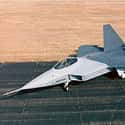-
(#13) Boeing YAL-1
- Aircraft model
Dating back to the Reagan years, the Boeing YAL-1 was part of the Airborne Laser program. Billions were spent on the machine, which was meant to be a massive futuristic machine that could shoot down ballistic projectiles using lasers. However, the machine proved a failure for a variety of reasons.
First, the lasers were not strong enough to shoot down enemy projectiles without orbiting dangerously close. Second, even if this could be corrected, the machine was extremely large. The army envisioned a fleet of Boeing YAL-1 aircrafts orbiting near enemy countries, but this would have been astronomically expensive. In the end, the Boeing YAL-1 became one of many that were too ineffective and expensive for the government to sustain.
-
(#3) F-22 Raptor
The $450 million machine that is the F-22 Raptor has never once in its 25-year history fired a shot in anger. The world's first fifth-generation fighter has yet to find a target deserving of risking its expensive hide, especially since the Soviet Union collapsed. True, there are other fifth-gen fighters out there, but they're all still playing catch-up to the F-22 in terms of design and performance.
Lockheed won't be making any new F-22s for the foreseeable future. You could call that a shame, but as long as we're not using it, that means we're not at war with anyone dangerous enough.
-
(#1) Horten HO 229 'Bat'
No, that's not a B-2 Spirit stealth bomber - it's the German wonder weapon that inspired it. The "Bat" wasn't just incredibly fast and futuristic - it was the world's first purpose-built stealth aircraft. Most historians agree that the conflict could have gone very differently if the "Bat" had actually entered service earlier, not least of which because of its planned big brother.
The "Amerikabomber" would have been capable of reaching New York or Washington from bases in Germany, slipping under our radar, dropping a few tons of explosive devices, and returning without refueling. The original "Bat," though, would have been more than sufficient to rain havoc all over Europe, Russia, and England with near impunity.
-
(#10) Tsar Bomba Hydrogen Device
How does one describe the most powerful man-made explosion in history - Russia's 50 megaton "Tsar Bomba"? All right, imagine a piece of the Sun about 2.2 miles in diameter suddenly appearing overhead. Now, imagine that 2-mile fusion fireball (itself bigger than the whole blast radius of "Little Boy") suddenly explodes, releasing all of its energy and simply vaporizing everything in a 20-mile radius. That's the entire city of London, turned into ash.
Everything within 50 miles perishes within hours, and within 100 miles a couple of days later. The mushroom cloud could be seen from 100 miles away, and the fallout could spread from New York to Colorado. The Tsar Bomba was never so much a weapon as it was a statement to the West: Beware the power of Mother Russia.
-
(#8) Boeing-Sikorsky RAH-66 Comanche
- Attack helicopter
In 1983, engineers at Boeing-Sikorsky began development of the RAH-66 Comanche as a means to replace Vietnam-era helicopters. The Comanche boasted some pretty bold features that would have made it an impressive machine had it came to be. With a body composed out of radar-absorbing material, the Comanche was 43 feet long and could fly up to 201 miles per hour. It also had state of the art navigation systems and the capacity to carry up to 12 stinger projectiles.
So, what happened? A string of bureaucratic nightmares slowed down production over the years, eventually leading to the project being altogether abandoned after the government poured $7 billion into the machine. It took six years for the army to issue a Request for Proposals and then an additional three years to draft a development contract. Boeing-Sikorski took an additional nine years to even begin the manufacturing phase in 2000. While the company produced two prototypes in the following two years, the government axed the project before mass production could begin.
Why did the government shut things down when the company was finally ready to mass produce the Comanche? The process took so long - as is typical when dealing with massive bureaucracies such as the government, private companies, and the US Army - that things had changed significantly. Since the project's original inception, the army's needs had evolved. The RAH-66 Comanche was simply no longer what the government wanted.
-
(#4) XB-70 Valkyrie
Back in the 1960s, the Air Force was in the market for a B-52 replacement capable of penetrating deep into enemy airspace without getting shot down by interceptors. The Valkyrie would have used a unique compression lift body and tons of power to sustain Mach 3 at 70,000 feet. Its frontal view would have also made it difficult to spot on the radar in time to scramble fighters.
Apart from massive budget over-runs and a new focus on slimming down the military, the Valkyrie was ultimately done in by the newest generation of ultra-fast surface-to-air projectiles, which rendered the Valkyrie's speed of little use.
New Random Displays Display All By Ranking
About This Tool
Our data comes from Ranker, If you want to participate in the ranking of items displayed on this page, please click here.






